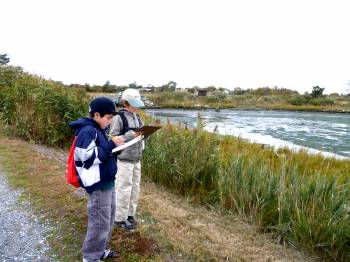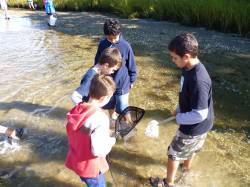Reflection on the EfS Curriculum Design Studio
/By Tom Scholz, 5th Grade Math & Science teacher, Trevor Day School,
New York, NY March 2, 2011

Last summer, I had the pleasure of taking one of the most productive professional development workshops in my sixteen years of teaching.
The Cloud Institute had asked participants of their Education for Sustainability Curriculum Design Studio to come prepared with a lesson plan or unit which would be worked on and viewed through the lens of the EfS standards. This made all the difference. I chose our fall science unit on Water/Salt Marsh Ecology.
Throughout each of the five days there was a combination of lectures, discussions, independent research and one-on-one coaching–an ebb and flow of ideas and productivity that I have not experienced in other workshops. By the end of the week, not only had I learned much in terms of what it means to “educate for sustainability,” but I also had a framework of ideas for an improved science unit for September.

Following the workshop with summer still in full swing, I met with my teaching colleague, Kevin Topping, another 5th Grade Math & Science teacher at my school, to develop the complete science unit. He had also been working with Jaimie Cloud over the past school year and was learning to apply the EfS standards to lessons. After sharing our ideas, conducting further research and taking several road trips to area nature preserves, Kevin and I fine-tuned what we hoped would be a more powerful science curriculum and experience for our students. After implementing the unit this past fall, we surveyed our students. Here is what they had to say:
When asked to reflect on what they had learned about salt marshes, James, 10, wrote, “I learned that a salt marsh is not just water and plants, but a cradle for infant animals, a somewhat hotel for migrating birds and fish, a place that is a huge filter for the world’s oceans, and it has a lot of mud!”

When asked about what topic in the unit they enjoyed learning about, Luke, 11, explained, “Biomimicry was my favorite topic in this section because of how amazing it is to learn from Mother Nature and how helpful it is. The world could be a lot greener and stronger if we followed Mother Nature’s techniques.” Ellie, 11, wrote, “I liked learning about the animals because I got to read about a fiddler crab, and then I got to see a live one close up. It was interesting to see his huge claw."

The students were asked to reflect upon something from the unit that they found so interesting they would like to continue learning about it. Avery, 10, wrote, “I want to learn more about the water troubles of not just New York but about the country. I would want to know how people felt and to learn how their machines carved through stone and how they made the pipes that flow from upstate to here.”

Based on the students’ reflections and my observations, I felt that the Cloud Institute’s Curriculum Design Studio enabled me to view my lesson objectives with sustainability in mind. Overall, we improved this science unit and made it more authentic. The EfS standards are tools to help structure and reinforce the important concepts and understandings that you want your students to take away and remember from lessons. These are not just important facts, but also powerful beliefs that will drive their understanding further, empower them to question what’s happening in their world, and ultimately inspire them to find the answers.
